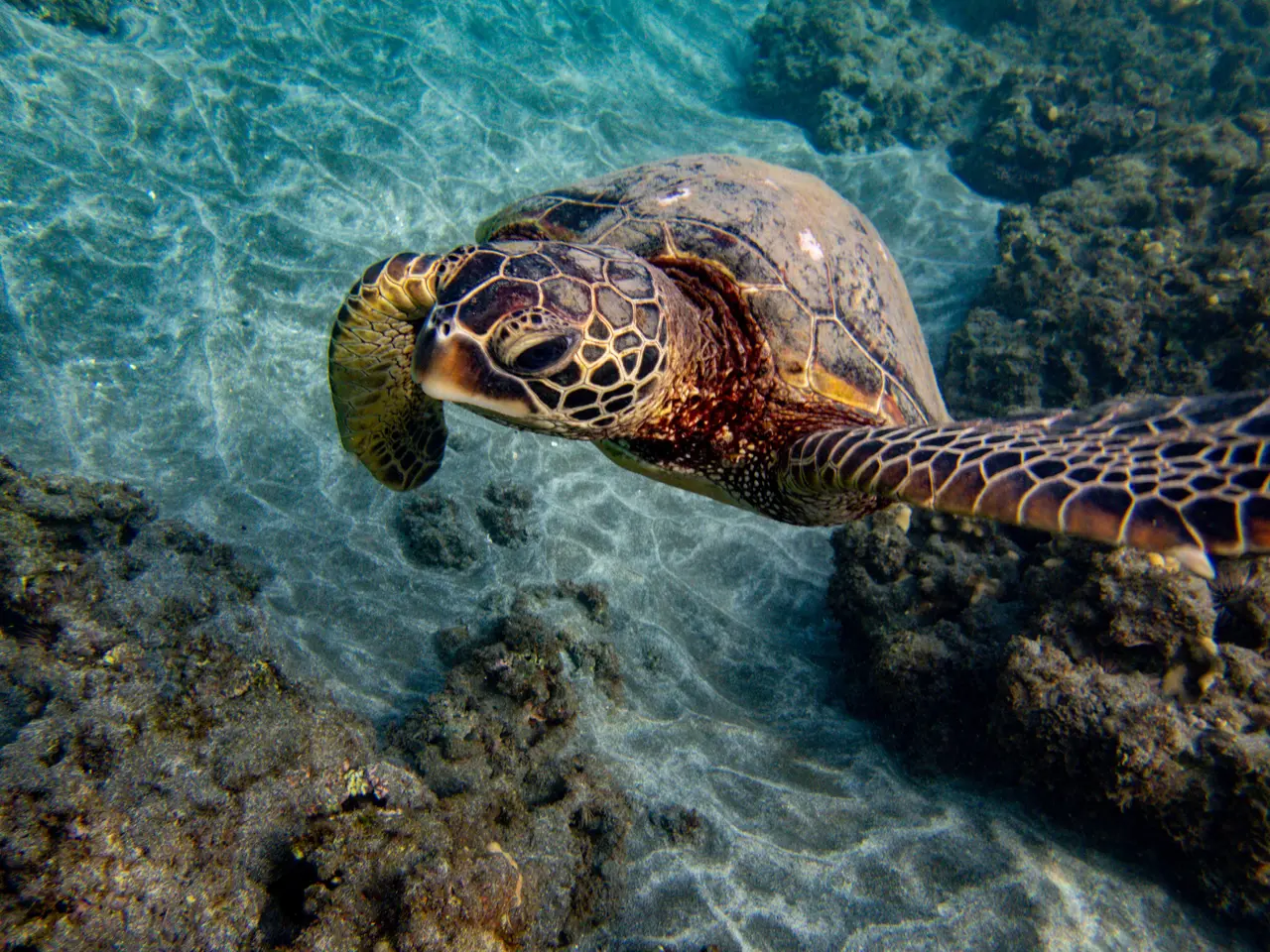Who knew these Honu facts?
Honu, or Hawaiian green sea turtles, are mesmerizing creatures that have captivated the hearts of many. These gentle giants are not only beautiful but also have fascinating habits and histories. In this blog, we’ll explore some surprising facts about honu, shedding light on their lives, habitats, and the conservation efforts that protect them. Get ready to dive into the world of these amazing turtles!
Hawaiian Green Sea Turtle - Honu
What are Honu?
Honu, specifically known as Hawaiian green sea turtles, are a unique species that inhabit the warm waters of the Pacific Ocean. These magnificent creatures are distinguished by their beautiful brownish olive-green shell, which can grow up to four feet in length. They can weigh as much as 400 pounds, making them one of the larger sea turtle species. More than just an impressive sight, honu play a crucial role in maintaining healthy coral reefs, which are vital to the ecosystem.
One of the most intriguing aspects of honu is their long lifespan. While many turtles face threats from predators and habitat loss, honu can live for over 50 years, and some even reach the ripe age of 80! This longevity allows them to witness significant changes in their environment, making them incredible indicators of ocean health.
Another fascinating characteristic of honu is their migratory behavior. These turtles travel great distances, sometimes over a thousand miles, between feeding and nesting sites. Such long journeys showcase not only their impressive navigation skills but also highlight the importance of protecting migratory routes in the face of climate change and human interference.
The Life Cycle of a Honu
The life cycle of a honu is filled with both wonder and challenges. It begins when female honu return to their natal beaches to lay eggs, often after traveling great distances. During nesting season, which peaks in the summer months, a female can lay between 80 to 100 eggs in a single nest. She will dig between 2 and 5 nests. These eggs incubate for about two months before they hatch, and this is where the adventure truly starts.
Upon hatching, baby honu, also called hatchlings, face a perilous journey. They must make their way from the sandy beach to the ocean, navigating a multitude of predators along the way, including crabs, birds, and fish. This risky dash to safety is a critical moment in their lives, and only a small percentage of hatchlings will survive to adulthood.
Once in the open ocean, juvenile honu will spend several years in the deeper water, where they develop and grow. During this stage, they are opportunistic feeders. Eating whatever they can find, from plankton to fish to unfortunately, micro bits of plastic. Once they return to coastal areas, the honu are pretty much herbivores, eating mostly algae and occasionally sponges. As they mature, they make their way back to the area where they hatched to breed, completing their life cycle. It’s a testament to their resilience and adaptability in a world filled with challenges and changes.
Honu Habitat: Where Do They Live?
Honu are primarily found in warm, shallow waters around coral reefs and seagrass beds, which serve as their ideal habitat. These environments provide not only a food source but also a safe place for nesting and shelter from predators. The vibrant ecosystems in which they dwell are a sanctuary that nurtures their growth and well-being.
One of the most significant habitats for honu is the coast of Hawaii, where they are revered and protected. Those who inhabit these waters often bask on sandy beaches, soaking up the sun and replenishing their energy. While they may be found in various oceanic regions, including the Indian and Pacific Oceans, Hawaiian waters offer a unique environment that young turtles recognize as their home.
However, many of these habitats are under threat due to human activities such as coastal development, pollution, and climate change. Sea-level rise, warming ocean temperatures, and the degradation of coral reefs pose significant risks to honu and their habitats. Safeguarding these critical ecosystems is essential for the survival of this beloved species.
Unique Characteristics of Honu
Honu possess several unique characteristics that make them stand out among sea turtles. One of the most remarkable features is their large, paddle-like flippers, which allow them to gracefully glide through the water. Each honu has a distinct pattern on its shell, much like a human fingerprint, helping researchers identify individuals within populations.
Another characteristic that sets honu apart is their diet. Unlike many other sea turtles that consume jellyfish, honu are primarily herbivorous. They thrive on seagrass and algae, playing a crucial role in maintaining the health of marine environments by controlling algal growth and promoting seagrass bed vitality.
Additionally, honu have a fascinating social structure. While they are not as social as some marine species, they can often be seen interacting with one another in gentle ways. This behavior showcases their unique personalities and allows them to establish social bonds, even if only temporarily.
Cultural Significance of Honu in Hawaiian Culture
In Hawaiian culture, honu are revered not just for their grace and beauty, but also for their symbolic meanings. They are often seen as a representation of wisdom, long life, and the spirit of the ocean. The local people believe that honu embody the spirit of ancestors and serve as guardians of the sea, a belief that underscores their cultural significance.
Honu are also featured in numerous Hawaiian folklore stories, often illustrating the turtles' connection to the land and ocean. These tales reinforce the importance of respecting and protecting this majestic species, emphasizing the harmonious relationship between nature and the people of Hawaii.
Moreover, the honu is a powerful symbol of resilience and survival, particularly as many face the challenges of modernity. Their presence serves as a reminder of the interconnectedness of all living things and encourages people to honor and preserve the natural world, a tenet deeply rooted in Hawaiian cultural practices.
Conservation Efforts for Honu
Fortunately, efforts are underway to protect honu and their habitats. Conservation programs are established in various regions, focusing on public awareness, habitat protection, and rehabilitation of injured turtles. Many organizations collaborate with local communities to promote sustainable practices and create protected areas where honu can thrive without human interference.
Legal protections have also been put in place for honu. In the United States, they are listed as threatened under the Endangered Species Act, which provides them with certain legal rights and protections. Monitoring populations and regulating interactions with humans, such as fishing practices and boat traffic, are essential components of these efforts.
Despite these conservation measures, challenges remain. Climate change, habitat degradation, and pollution pose ongoing threats to marine life, including honu. Continued efforts from individuals, communities, and governments are necessary to support these gentle giants and ensure their place in the ocean for future generations.
How You Can Help Honu
The good news is that there are several ways individuals can contribute to the conservation of honu. One of the simplest actions is to educate yourself and others about the importance of these turtles and their habitats. Sharing knowledge can inspire others to take part in protective measures that benefit honu.
Another vital step is to reduce waste and plastic use, as marine debris poses a grave threat to honu. By minimizing single-use plastics and participating in beach cleanups, you can help keep their environment safe. Additionally, supporting organizations dedicated to sea turtle conservation can have a lasting impact on protecting these creatures.
Lastly, if you’re lucky enough to encounter a honu while snorkeling or swimming, remember to respect their space. Keeping a safe distance not only protects the turtles but also allows you to appreciate their beauty without causing them stress. By taking these actions, you can contribute to the ongoing efforts to protect our beloved honu.
Conclusion: Protecting Our Honu
As we’ve discovered, the honu are more than just stunning creatures; they are vital components of marine ecosystems and carry cultural significance in Hawaiian tradition. By learning about these facts and supporting conservation efforts, we can all contribute to the protection of honu for generations to come. Let's appreciate and protect these incredible turtles!

